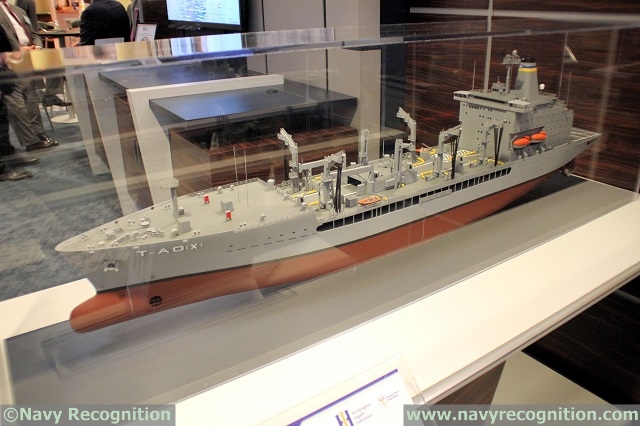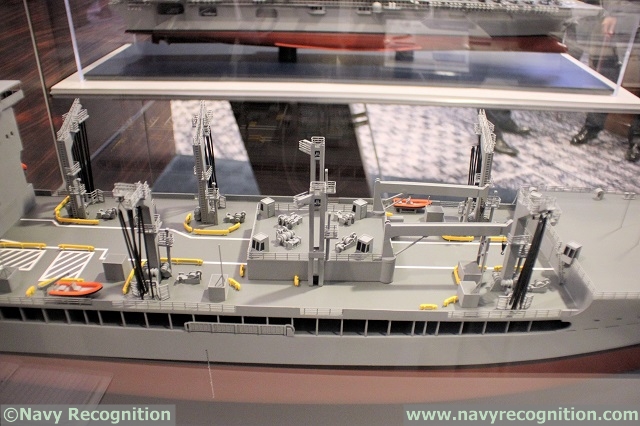 T-AO(X)
Fleet Oiler Scale Model on HII stand at SNA 2016 T-AO(X)
Fleet Oiler Scale Model on HII stand at SNA 2016 |
|||
An
HII representative at SNA 2016 told Navy Recognition that T-AO(X) is based
on the successful T-AO Henry J. Kaiser class ships. The two vessels will
look very similar, except the new T-AO(X) hull has been stretched. We
were explained cargo area, stern and bow are all lengthened (i.e. the
hull isn't strechted thanks to a single module). T-AO(X) and Kaiser class share the same number of cargo transfer stations (5x wet and 2x dry). T-AO(X) is set to be fitted with a new Underway Replenishment (UNREP) system known as E-STREAM (or Heavy Electric - Standard Tensioned REplenishment Alongside Method). The new system increases the rate at which cargo can be transferred between ships at sea as well as doubles the nominal maximum load that can be transferred. These capabilities are made possible by utilizing technologies, such as, Variable Frequency Drives (VFD), Programmable Logic Controllers (PLC), and varying sensing devices to monitor and control the transfer of cargo. Along with Heavy, the E-STREAM family will consist of a Fueling-At-Sea (FAS) and Replenishment-At-Sea (RAS) system, which have the same capabilities as the existing STREAM system. The first Heavy E-STREAM system was tested at sea for nine-month aboard USNS Arctic. We were told during SNA 2016 that T-AO(X) is fitted with a double hull, as is the case for the last 3 oilers of the Kaiser class (according to the lastest environmental standards). There is space and weight provision for two self defense systems (should the US Navy decide to fit them on the class). While the Kaiser class displace 41,000 tons with a length of 677 feet (206 meters), T-AO(X) is set to be 209 meters in length and displace 50,000 tons. |
|||
 Detailed
view of the 7x cargo transfer stations on T-AO(X) Detailed
view of the 7x cargo transfer stations on T-AO(X) |
|||
Background In June 2015, the U.S. Navy issued a request for proposal to both HII and General Dynamics NASSCO to manufacture the first six T-AO(X). As we reported, the U.S. Secretary of the Navy (SECNAV) Ray Mabus just announced that the first ship of the T-AO(X) next generation of fleet replenishment oilers (T-AO 205) will be named USNS John Lewis. A contract will be awarded for the ship in summer 2016 and construction is expected to begin in 2018. |
|||
SNA 2016: Huntington Ingalls Industries' T-AO(X) Fleet Replenishment Oiler Model
- Posted On










